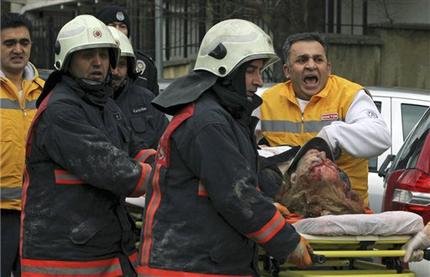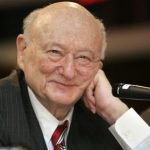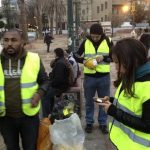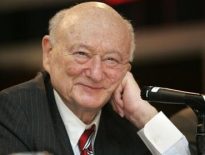ANKARA, Turkey (AP) — In the second deadly assault on a U.S. diplomatic post in five months, a suicide bomber struck the American Embassy in Ankara on Friday, killing a Turkish security guard in what the White House described as a terrorist attack.

Washington immediately warned Americans to stay away from all U.S. diplomatic facilities in Turkey and to be wary in large crowds.
Turkish officials said the bombing was linked to leftist domestic militants.
The attack drew condemnation from Turkey, the U.S., Britain and other nations and officials from both Turkey and the U.S. pledged to work together to fight terrorism.
“We strongly condemn what was a suicide attack against our embassy in Ankara, which took place at the embassy’s outer security perimeter,” said White House spokesman Jay Carney.
“A suicide bombing on the perimeter of an embassy is by definition an act of terror,” he said. “It is a terrorist attack.”
Turkish Prime Minister Recep Tayyip Erdogan said police believe the bomber was connected to a domestic leftist militant group. Carney, however, said the motive for the attack and who was behind it was not known.
A Turkish TV journalist was seriously wounded in the 1:15 p.m. blast in the Turkish capital, and two other guards had lighter wounds, officials said.
The state-run Anadolu Agency identified the bomber as Ecevit Sanli. It said the 40-year-old Turkish man was a member of the outlawed Revolutionary People’s Liberation Party-Front, or DHKP-C, which has claimed responsibility for assassinations and bombings since the 1970s.
The group has been designated a terrorist organization by the United States but had been relatively quiet in recent years.
Hillary Rodham Clinton, in her farewell speech to State Department staff moments after she formally resigned as secretary of state, said “we were attacked and lost one of our foreign service nationals.”
She said she spoke with U.S. Ambassador Francis Ricciardone, “our team there and my Turkish counterpart. I told them how much we valued their commitment and their sacrifice.”
Sen. John Kerry, the incoming secretary of state, also was briefed.
The U.S. Embassy building in Ankara is heavily protected and located near several other embassies, including those of Germany and France.
U.S. diplomatic facilities in Turkey have been targeted previously by terrorists. In 2008, an attack blamed on al-Qaida-affiliated militants outside the U.S. Consulate in Istanbul left three assailants and three policemen dead.
On Sept. 11, 2012, terrorists attacked a U.S. mission in Benghazi, Libya, killing U.S. Ambassador Chris Stevens and three other Americans. The attackers in Libya were suspected to have ties to Islamist extremists, and one is in custody in Egypt.
Friday’s bombing occurred at a security checkpoint at the side entrance to the U.S. Embassy, which is used by staff.
State Department spokeswoman Victoria Nuland said a man detonated a suicide vest at the checkpoint on the outer perimeter of the embassy compound.
“He came to this first point of access to the compound … where you have to have your ID checked, you have to go through security,” Nuland said.
The guard who was killed was standing outside the checkpoint, while the two wounded guards “were standing in a more protected area,” said Interior Minister Muammer Guler said.
The two were treated on the scene and did not require hospital treatment, he said.
“The level of security protection at our facility in Ankara ensured that there were not significantly more deaths and injuries than there could have been,” Nuland told reporters in Washington.
“This is one of the compounds where we have been making steady security upgrades over the last decade,” Nuland said. “And in fact, the attack was at one of the exterior compound access sites. So it was far from the main building, and it was a result of the way that was hardened that we only lost the one local security guard. And in fact, there were other security guards inside the building behind the glass who were only shaken up by this.”
While praising its security and the response of Turkish authorities, Nuland noted that the embassy in Ankara is due for a completely new compound in future. She described the current main building as a 1950s complex that “needs a full upgrade.”
The Hurriyet newspaper said staff at the embassy took shelter in a “safe room” inside the compound soon after the explosion.
Police swarmed the area and immediately cordoned it off. Forensic investigators in white outfits and gloves soon combed the site.
TV news video showed the embassy door blown off its hinges. The blast also shattered the windows of nearby businesses, littering debris on the ground and across the road. The inside of the embassy did not appear to be damaged.
Television video also showed what appeared to be a U.S. guard in a helmet and body armor surveying the area from the roof of an embassy building.
In a statement, the U.S. Embassy thanked Turkey for “its solidarity and outrage over the incident.”
Ricciardone declared that the U.S. and Turkey “will continue to fight terrorism together,” and described the U.S. Embassy compound as secure.
“From today’s event, it is clear that we both suffer from this terrible, terrible problem of today’s world. We are determined after events like this even more to cooperate together until we defeat this problem together,” he said.
Erdogan echoed that sentiment, saying the attack aimed to disturb Turkey’s “peace and prosperity” and demonstrated a need for international cooperation against terrorism.
“We will stand firm and we will overcome this together,” he said.
Nuland said U.S. officials were “working closely with the Turkish national police to make a full assessment of the damage and the casualties, and to begin an investigation.”
Carney, the White House spokesman, said the attack would strengthen the resolve of Turkey and the U.S.
“Turkey remains one of our strongest partners in the region, a NATO ally,” he said. “We have worked shoulder-to-shoulder with the Turks to counter terror threats. Turkey has been a very important ally, broadly speaking and in the effort to counter terrorism.”
Foreign Minister Ahmet Davutoglu vowed Turkey would spare no effort in protecting diplomatic facilities.
“We have always shown great sensitivity to the protection of foreign missions and we will continue to do so,” he said.
The injured journalist was 38-year-old Didem Tuncay, who until recently had worked for NTV television. A hospital official said she was “not in critical condition.”
Ricciardone visited her in the hospital and told reporters outside that he had invited her to the U.S. Embassy for tea.
He also paid tribute to the Turkish guard who was killed, calling him a “Turkish hero” who died while defending U.S. and Turkish staff.
Americans in Turkey were warned to avoid visiting the embassy or U.S. consulates in Istanbul and Adana until further notice and were told to register on the State Department’s website.
“The Department of State advises U.S. citizens traveling or residing in Turkey to be alert to the potential for violence, to avoid those areas where disturbances have occurred, and to avoid demonstrations and large gatherings,” the U.S. Consulate in Istanbul said in a statement.
British Foreign Secretary William Hague condemned the attack “in the strongest terms” and said Turkey and the U.S. will get the U.K.’s full support as they seek to hold those responsible to account.
NATO Secretary-General Anders Fogh Rasmusen added his condemnation, calling it “an outrageous attack” that “shows a reckless disregard for human life and for the inviolability of diplomatic staff.”
Israeli Prime Minister Benjamin Netanyahu sent a message to President Barack Obama, saying he was “shocked and saddened to learn of the vicious terrorist attack.”
Ed Royce, the chairman of the U.S. House Foreign Affairs Committee, said the attack was “another stark reminder of the constant terrorist threat against U.S. facilities, personnel and interests abroad.”
“Coming after Benghazi, it underscores the need for a comprehensive review of security at our diplomatic posts. The committee stands ready to assist the State Department in protecting our diplomats,” he said in a statement.
Turkey’s parliament speaker, Cemil Cicek, linked Friday’s attack to the arrest last month of nine Turkish human rights lawyers, who prosecutors have accused of links to the DHKP-C.
“There was an operation against this organization,” Cicek said and suggested the attack could be an attempt by the group to “say `We are still here, we are alive.'”
James F. Jeffrey, a visiting fellow at the Washington Institute for Near East Policy who was U.S. ambassador in Turkey between 2008 and 2010, said DHKP-C was a resilient group that had been “relatively quiescent” in recent years. He said the organization was born out of the 1970s European tradition of pro-communist terrorism, and he drew a parallel with Germany’s now-defunct Baader-Meinhof gang.
“I do not see them as a major threat compared to al-Qaida,” Jeffrey said of DHKP-C in a conference call with journalists. The group, he said, typically attacks with small arms and conducts periodic assaults “just to make sure people know they’re still out there.”
He said it seemed to have “very deep roots” and means of recruitment in several urban centers, including Istanbul, Ankara and possibly the coastal city of Izmir. Jeffrey said it was unlikely the attack was a response to recent regional developments – including, for example, Israel’s strike this week on a Syrian target – but did not rule out that DHKP-C conducted the bombing as a kind of subcontractor for another group.
He also said the embassy’s strong defenses worked as they were supposed to, with the “minimum number of casualties” for such a grave attack.
“It’s a very hard perimeter to crack, as we saw today,” Jeffrey said.
In past years, the DHKP-C group has spearheaded hunger strikes against Turkish prison conditions that led to the deaths of dozens of inmates. The protesters opposed a maximum-security system in which prisoners were held in small cells instead of large wards.
In September, police said a leftist militant threw a grenade and then blew himself up outside a police station in Istanbul, killing a police officer and injuring seven others. Police identified the bomber as a member of the DHKP-C.
In 2008, Turkish police said they had foiled a bomb plot by DHKP-C against some U.S. companies in Turkey.
Turkey has also seen attacks linked to homegrown Islamic militants tied to al-Qaida. In a 2003 attack on the British consulate in Istanbul, a suspected Islamic militant rammed an explosive-laden pickup truck into the main gate, killing 58 people, including the British consul-general.





